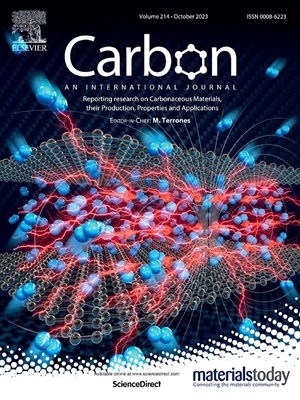Carbon vacancies boost plateau sodium storage in sieving carbon anodes
IF 10.5
2区 材料科学
Q1 CHEMISTRY, PHYSICAL
引用次数: 0
Abstract
Defects in hard carbon are primarily associated with the slope capacity arising from sodium ion adsorption on defect sites for sodium storage. However, the impact of defects on plateau sodium storage remains poorly understood owing to the difficulties for hard carbon in precisely customizing carbon defects in the walls of closed pores without changing other structures such as pore geometry. Here, sieving carbon is selected as a model material to study the role of defects within closed pores in plateau sodium storage, considering that its pore forming and pore sealing by chemical vapor deposition are decoupled during material preparation. Specifically, vacancy-dominated defects are formed within closed pores by hydrogen reduction of porous carbon precursor and an identical external surface with deposited carbon covered is obtained by chemical vapor deposition. Such a vacancy-rich sieving carbon exhibits a high specific capacity of 470 mAh g−1, along with an increased plateau capacity and improved cycling stability, remaining 72.3 % of its initial capacity after 400 cycles (342 mAh g−1). A series of spectroscopic studies demonstrate that increased carbon vacancies promote the formation of sodium clusters with higher reversibility in closed pores. This work provides new insights into the mechanism of plateau sodium storage and offers an effective strategy to improve the capacity and cycling stability of carbon anodes for sodium-ion batteries.

碳空位增加了筛分碳阳极的平台钠储存
硬碳中的缺陷主要与钠离子吸附在缺陷部位以储存钠而产生的斜坡容量有关。然而,由于硬碳很难在不改变其他结构(如孔隙几何形状)的情况下精确定制封闭孔隙壁上的碳缺陷,因此,缺陷对高原钠储存的影响仍然知之甚少。本文选择筛分碳作为模型材料,考虑到其成孔和化学气相沉积封孔在材料制备过程中是解耦的,研究了封闭孔内缺陷在高原储钠过程中的作用。具体来说,通过氢还原多孔碳前驱体在封闭孔隙内形成以空位为主的缺陷,并通过化学气相沉积获得与沉积碳覆盖相同的外表面。这种富含空位的筛分碳表现出高达470 mAh g−1的高比容量,同时增加了平台容量和改善的循环稳定性,在400次循环(342 mAh g−1)后仍保持其初始容量的72.3%。一系列的光谱研究表明,碳空位的增加促进了封闭孔隙中具有更高可逆性的钠簇的形成。本研究为研究钠离子电池的平台储钠机制提供了新的思路,并为提高钠离子电池碳阳极的容量和循环稳定性提供了有效的策略。
本文章由计算机程序翻译,如有差异,请以英文原文为准。
求助全文
约1分钟内获得全文
求助全文
来源期刊

Carbon
工程技术-材料科学:综合
CiteScore
20.80
自引率
7.30%
发文量
0
审稿时长
23 days
期刊介绍:
The journal Carbon is an international multidisciplinary forum for communicating scientific advances in the field of carbon materials. It reports new findings related to the formation, structure, properties, behaviors, and technological applications of carbons. Carbons are a broad class of ordered or disordered solid phases composed primarily of elemental carbon, including but not limited to carbon black, carbon fibers and filaments, carbon nanotubes, diamond and diamond-like carbon, fullerenes, glassy carbon, graphite, graphene, graphene-oxide, porous carbons, pyrolytic carbon, and other sp2 and non-sp2 hybridized carbon systems. Carbon is the companion title to the open access journal Carbon Trends. Relevant application areas for carbon materials include biology and medicine, catalysis, electronic, optoelectronic, spintronic, high-frequency, and photonic devices, energy storage and conversion systems, environmental applications and water treatment, smart materials and systems, and structural and thermal applications.
 求助内容:
求助内容: 应助结果提醒方式:
应助结果提醒方式:


